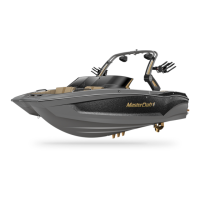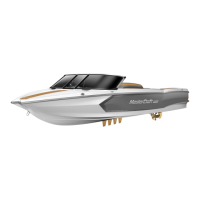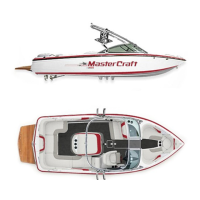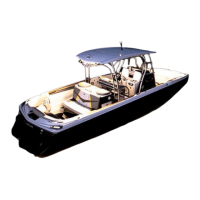have the same performance. Although some performance can
be regained by dropping to a lower-pitch propeller, the basic
condition still exists. The propeller is too large in diameter for
the reduced power output. An experienced marine dealer can
determine how much diameter to remove from a lower-pitch
propeller for specific high-elevation locations.
Aviara’s engine manufacturers suggest that consumers consult
with the dealer from whom the boat was purchased regarding
the best propeller for the application in which the boat will
primarily be run. However, be aware that changing the propeller
may void the warranty. Again, working with an authorized Aviara
dealer is your best bet to ensure excellent performance.
Unusual Operating Conditions
If the body of water is unknown, talk to local boaters about the
type of obstacles that may be encountered beneath the water’s
surface. Rocks, tree stumps and sandbars are all dangerous
and damaging. Be especially wary of rivers and man-made
lakes. Rapidly changing conditions can cause daily changes in
underwater hazards.
Stay well clear of floating debris. What looks to be a small
branch in the water may well turn out to be an entire tree.
When traveling through weedy areas, keep an eye on the engine
temperature gauge. Weeds caught up and blocking the water
flow through the raw water intake will cause trouble. Also, after
leaving the weedy area, shift to neutral for a few seconds and
then to reverse for a few seconds to unwind any weeds that
may have wrapped around the propeller.
Docking and Tie-Up
Approach the dock slowly, with the starboard side of the boat
if possible for better access to the dock. Before tying up the
boat, be sure to use enough fenders to protect the boat from
damage. If possible, tie-up with the bow toward the waves. Use
good quality double-braided nylon line. Tie-up only to the cleats
or tie-down eyes. Never use the handrails.
Boats left at docks or at anchor must be monitored on a regular basis
to avoid sinking. Maintain adequate battery charge to keep the bilge
pumps operational to avoid excess water intrusion. If leaking is
detected, immediately remove the boat from the water and determine
the cause.
If the boat is to be moored for a long period of time, use
chafing protectors to protect the gel coat finish. Leave a little

